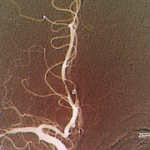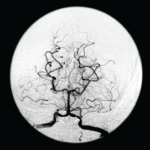Conclusion: Prominent gadolinium leptomeningeal enhancement on MRI may point to a distinct subtype of PCNSV with small leptomeningeal artery vasculitis and rapid response to therapy.
Primary central nervous system vasculitis in children. (Arthritis Rheum. 2006;54:1291-1297.)
Abstract
Objective: Primary angiitis of the central nervous system (PACNS) is a severe and ill-defined neurologic disease. The goal of this study was to characterize the presenting features, treatment, and neurologic outcome of PACNS in children (cPACNS) and to define the predictors of disease progression in order to identify high-risk patients with cPACNS.
Methods: The cohort comprised consecutive patients diagnosed as having cPACNS based on clinical and vascular imaging findings, including identification of arterial stenosis on conventional angiography or magnetic resonance (MR) angiography. Disease progression was defined angiographically at more than three months after initial angiography. Clinical data obtained in prospectively collected standardized assessments and results of laboratory tests, including detection of cerebrospinal fluid abnormalities, were noted, and neuroimaging studies were reanalyzed. Predictors of progression were identified and tested in multivariate regression models.
Results: Sixty-two consecutive patients with cPACNS (38 male, 24 female, median age 7.2 years) were included. Two distinct subgroups were identified, those with progressive disease and those with nonprogressive disease. Progressive cPACNS was found in 20 of 62 children and was predicted by a clinical presentation of neurocognitive dysfunction, multifocal parenchymal lesions on MR imaging, and evidence of distal stenoses on angiography.
Conclusion: The spectrum of PACNS in children includes both progressive and nonprogressive forms. Characteristic features at diagnosis can be used to predict later progression, to identify a distinct high-risk cPACNS cohort, and to help guide selection of patients for immunosuppressive therapy.
Efficacy of tumor necrosis factor alpha blockade in primary central nervous system vasculitis resistant to immunosuppressive treatment. (Arthritis Rheum. 2008;59:291-296.)
Introduction
Primary central nervous system vasculitis (PCNSV) is an uncommon form of vasculitis that is limited to the brain and spinal cord. PCNSV may be associated with serious morbidity and mortality unless it is treated with high-dose corticosteroids and immunosuppressive medications.
Because of the lack of controlled clinical trials and uniform diagnostic criteria, uncertainties exist regarding the response to treatment and the long-term outcome of PCNSV. Some patients may have a more benign course and may need less intense therapy. Others require more aggressive therapy. Still others experience recurrent symptoms or have severe adverse effects, therefore new treatment options are needed.
We report two patients with PCNSV who did not respond to treatment with corticosteroids and immunosuppressive medication. They were treated with tumor necrosis factor (TNF) blockers in an attempt to control the disease. This study was approved by the Mayo Clinic Institutional Review Board.

